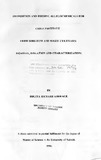| dc.description.abstract | A study was carried out to isolate and identify the chemicals from sorghum and maize
that determine the oviposition and feeding responses, respectively, of the moth and larvae of
Chilo partellus a serious pest of these crops. Studies were carried out on a resistant and a
susceptible cultivar of maize (MP 704 resistant; INBRED A susceptible) as well as sorghum
(IS 1044 resistant; IS 18363 susceptible). The allelochemicals were extracted sequentially with
petroleum ether, ethyl acetate and methanol. The sorghum cultivars showed quantitative rather
than qualitative differences while the maize cultivars showed both qualitative and quantitative
differences in respect to the concentrations of the constituent chemical compounds.
The maize feeding bioassay was carried out using impregnated cellulose acetate discs.
The sorghum ovipositional bioassay was carried out using filter paper as plant substrate. The
maize methanolic extracts showed greater feeding stimulation than ethyl acetate extracts and
these in turn showed greater feeding stimulation than the petroleum ether extracts. The
susceptible cultivar extracts elicited more feeding stimulation than those of the resistant
cultivars. The sorghum petroleum ether extracts showed significant C.parte/Ius ovipositional
inhibition unlike the ethyl acetate and methanol extracts which showed very weak
ovipositional activity or none at all. The pet-ether extract of the resistant cultivar showed the
greatest oviposition inhibition.
Chemical study of the extracts revealed a variety of compounds on the leaf whorls.
A series of n-alkanes with carbon chain C10 -CIS were common in all the maize and sorghum
cultivars. These were however found to have no observable effect on Chilo partellus
oviposition. The compound, methyl 1l,14,17-eicosatrienoate, isolated from the sorghum
resistant cultivar petroleum ether extract showed significant ovipositional inhibition. This
compound was in large amounts in the resistant cultivar. Three compounds were isolated from
the maize resistant cultivar ethyl acetate extract; 4-hydroxybenzoic acid, 4-ethoxybenzoic
acid and 4,5,6,7-tetrahydro-2-1H-isoindole-l,3(2H)-dione. 4-Hydroxybenzoic acid was in
large amounts in the susceptible cultivar compared with the resistant cultivar and is a known
C.partellus feeding stimulant. 4-Ethoxybenzoic acid, also in larger amounts in the susceptible
cultivar compared to the resistant, has not been tested independently for bioactivity. 4,5,6,7Tetrahydro-2-IH-isoindole-l,
3(2H)-dione was found in large amounts in the resistant cultivar.
It has not been tested independently for bioactivity although a study of the H.P.L.C profiles
of the cultivars suggests that this compound, along with another that was difficult to isolate,
could be responsible for the observed reduced C.partellus feeding stimulation in the resistant
cultivar by acting as antifeedants.
Structural elucidation of each of these compounds was performed on the basis of their
spectroscopic data. The range of compounds isolated and characterized indicates that there
may be a vast reservoir of yet untapped allelochemicals in food-crops which could be useful
in the breeding of pest resistant cultivars of the principle food-crops maize and sorghum. | en |

